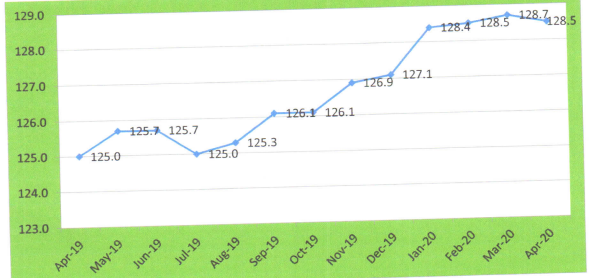Siquijor CPI marks at 128.5
As of April 2020 the survey of retail prices of commodities conducted by Philippine Statistics Authority (PSA) has generated a CPI of 128.5 using 2012 as the base year. It decreases from March 2020 which posted a CPI of 128.7. During the same period in 2019, the CPI was at 125.0. The CPI for April 2020 period implied that the cost of a basket of goods and services commonly purchased by typical Filipino households in the Province of Siquijor was at an average of P128.5.
Price indices are used for economic analysis and as a monitoring indicator of government’s economic policy. CPI is most widely used in the calculation of the inflation rate and purchasing power of peso. It is an indicator of the changes in the average retail prices of a fixed basket of goods and services commonly purchased by households relative to the base year. Table 1 below shows the CPI result of Siquijor by commodity group.
Table 1. Consumer Price Index (CPI) by Commodity Group: Siquijor (2012=100)

As shown in Table 1, commodities under Alcoholic Beverages and Tobacco continue to rise with CPI at 175.5. It was recorded at 174.8 in March 2020 and far at 158.0 on April last year. Second highest is the group under Furnishings, Household Equipment and Maintenance of the House which recorded a CPI at 141.8 but with no increase from the previous month record. Housing, Electricity, Gas and other Fuels recorded at 133.8. The rest of the commodity groups remain a CPI lower than the provincial average of 128.5 for all items.
Figure 1 below shows the graph of CPI for all items from April 2019 to April 2020.
Figure 1: Consumer Price Index (CPI) for all Items: Siquijor, March 2019 to March 2020

Siquijor Province Inflation lowered at 2.8% in April 2020
Siquijor inflation continues to lower in April 2020 which recorded at 2.8%. Last month the inflation was at 3.6% and much lower if April 2020 record compared to same period in April last year which has an inflation at 4.3%. Inflation Rate is the rate of change of the CPI expressed in percent. Inflation is interpreted in terms of declining purchasing power of peso.
See Table 2 for the year on year Inflation rate for all items.
Table 2. Year on Year Inflation Rate (All Items) and Purchasing Power of Peso (2012=100)

The decrease of inflation was mainly driven by most of the commodities that showed little changes in April 2020 from the same period last year (April 2019). See Table 3 below for the complete list of commodity group and its corresponding inflation rate.
Table 3. Consumer Price Index (CPI) and Inflation Rates by Commodity Group: Siquijor (2012=100)

Consumer Price Index and Inflation Rates of Selected Food Items
On the selected food items, highest inflation was recorded in Vegetable at 28.8% and followed by Fish, 11.5%, Food Products not elsewhere classified, 10.0%,Fruit Products, 4.2%, and Milk, Cheese and Eggs at 3.2%. Other food items have lower CPI than the All Items average at 2.8%. It is noted that the major food products continue to lower with a negative value especially on Rice with CPI at -7.4% and Bread and Cereals at -4.5%.
Table 4 shows the complete list of inflation rates of selected food items for April 2020.
Table 4. Consumer Price Index (CPI) and Inflation Rates of Selected Food Items: Siquijor (2012=100)

Purchasing Power of Peso (PPP) remains at 0.78
The purchasing power of peso in the province remains at 78 centavos for the fourth consecutive months already. Moreover, it is lower from last year same period (April 2019) with a value of 80 centavos. With 2012 as the base year and with P1.00 as its value, this means that in April 2020 PPP values only at Php 0.78.
Purchasing Power of Peso (PPP) is computed as the reciprocal of the CPI for the period under review multiplied by 100. The PPP is inversely related to inflation rate. Thus, as the inflation rate increases, PPP declines.
Figure 2 shows the declining graph of purchasing power of peso from April 2019 to April 2020.
Figure 2: Purchasing Power of Peso (PPP): Siquijor, 2012 = Php 1.00

TECHNICAL NOTES
Uses of CPI
The CPI is most widely used in the calculation of the inflation rate and purchasing power of peso. It is a major statistical series used for economic analysis and as monitoring indicator of the government economic policy.
Computation of CPI
The computation of CPI involves consideration of the following important points:
a. Base Period – The reference date or base period is the benchmark or reference date or period at which the index is taken as equal to 100.
b. Market Basket – A sample of the thousands of varieties of goods purchased for consumption and the services availed by the households in the country selected to represent the composite price behavior of sll goods and services purchased by consumers.
c. Weighting System – The weighting pattern uses the expenditures on various consumer items purchased by households as a proportion to total expenditure.
d. Formula – The formula used in computing the CPI is the weighted arithmetic mean of price relatives, the Laspeyre’s formula with a fixed base year period (2012) weights.
e. Geographic Coverage – CPI values are computed at the national, regional, and provincial levels, and or selected cities.
(SGD.) AURELIA M. CANDA
Chief Statistical Specialist




